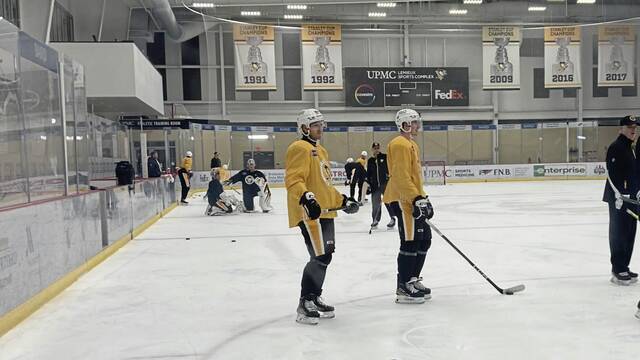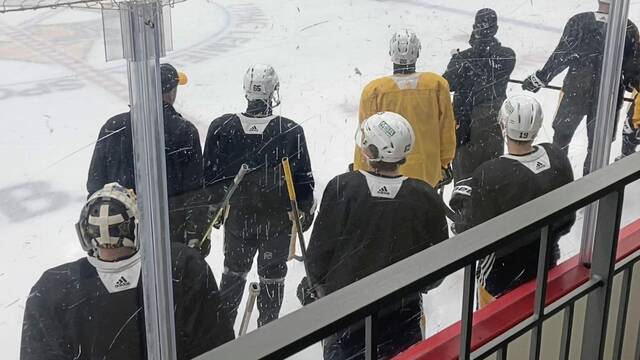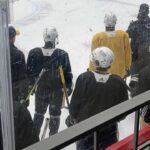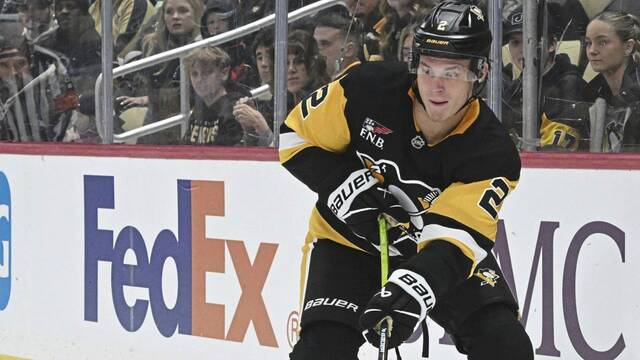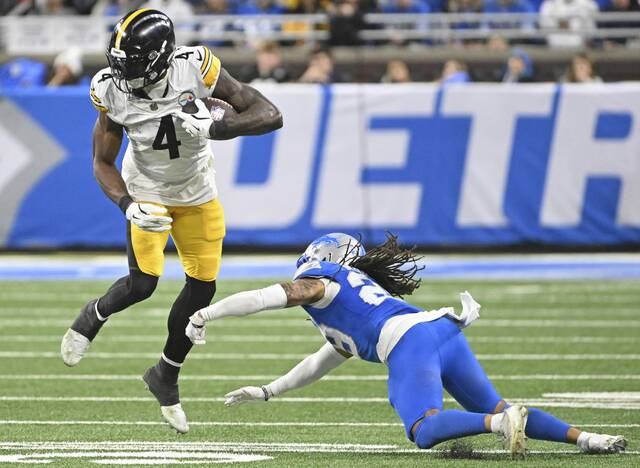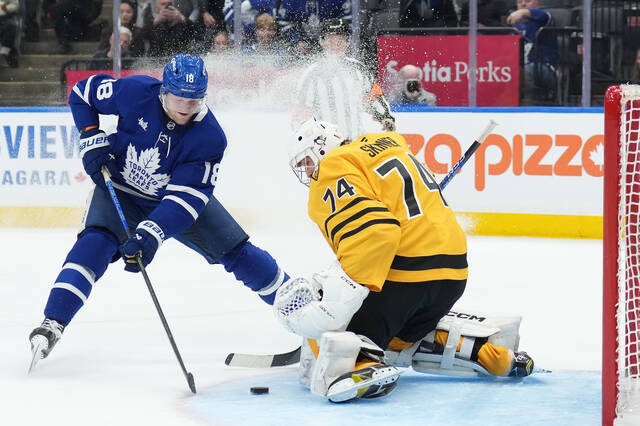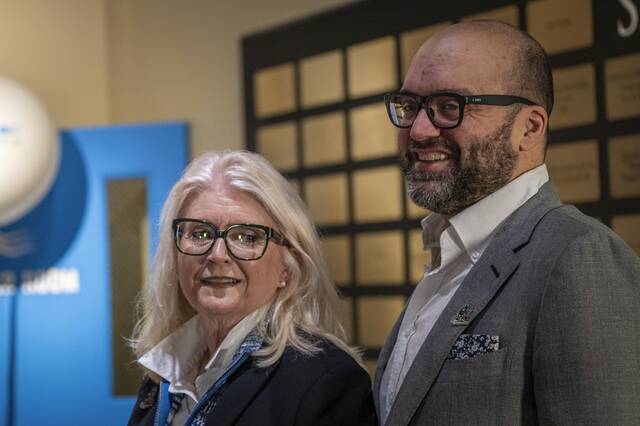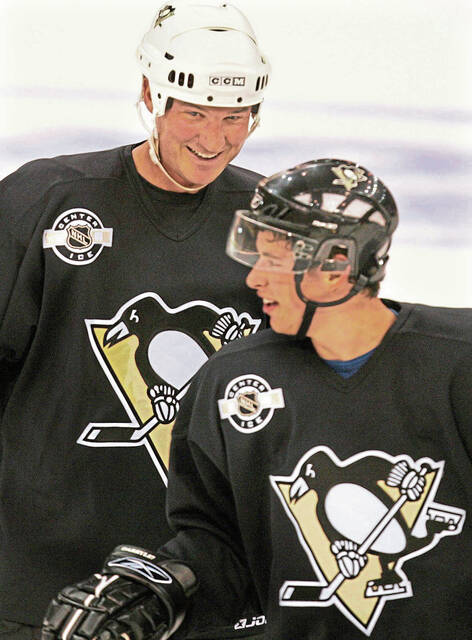Lars Eller wore neck guards throughout his youth in Denmark as well as during his junior and early professional days in neighboring Sweden.
They were “mandatory as far as I recall.”
Then, when the sturdy defensive forward came to North America in 2009 to play for the St. Louis Blues organization, he stopped using one.
The reason was simple.
“I don’t think they were even offered,” Eller said. “I didn’t ask, but nobody was wearing them. They weren’t given out. It was just kind of assumed that no one wanted to use them.”
Eller and a handful of his current teammates on the Pittsburgh Penguins did use during practice Thursday in Cranberry, less than a week after former Penguins forward Adam Johnson died from a skate cut to his neck while playing in the United Kingdom on Saturday.
Eller as well as defensemen Ryan Graves, Erik Karlsson and Marcus Pettersson wore the neck guards during practice. Goaltender Magnus Hellberg did as well, but he has done so for several years given the unique nature of his position.
The calls for players to wear equipment that better protects the neck have been ample since Johnson’s death, and the Penguins have mandated them for their American Hockey League (Wilkes-Barre/Scranton) and ECHL (Wheeling Nailers) affiliates.
No such mandate can be made for the NHL roster without approval from the NHL Players’ Association, though Penguins coach Mike Sullivan indicated it will be heavily suggested to his players.
There is little to suggest NHLers will push back on the idea.
“Over the next little while here, we’re going to see a lot of different brands come in with a lot of different potential options for players,” said forward Bryan Rust, who played briefly with Johnson. “Some guys are going to step up and start wearing them. You see it happening all over the hockey world. Once guys find something they like and they’re comfortable with them, I would assume more players would start wearing them.”
The biggest impediment to that pursuit is supply. Equipment outfitters have been inundated with requests for neck protectors since Saturday at all levels of hockey, from the professional ranks to youth leagues.
For NHLers, virtually every piece of equipment they currently wear is custom-made to a granular level. Vendors from equipment outfitters routinely visit teams throughout the season to take measurements and feedback from players on how to improve skates, shoulder pads and helmets.
Neck guards appear to be the next item on most inventories.
“Guys are very particular with (gear) and how they fit and stuff,” Rust said. “Having not worn neck guards for a while, I think it’s going to take an adjustment period for those that want to give it a serious try.”
For Eller, Graves, Karlsson and Pettersson, they largely wore neck guards Thursday to test them out.
“Probably try it out for a little bit and see if I can get accustomed to it and then go from there,” Karlsson said. “I grew up in Sweden. Playing with (a) neck guard was mandatory, even in the men’s league, and I think it still is. I don’t know if we wore it properly, but it was still something we had to wear right when we started playing hockey. I obviously haven’t done it for a long time, but (we’ll) see if I can get back into it.
“Anything is better than nothing, so we’ll see where it goes.”
Eller and Pettersson each indicated their usage Thursday was uncomfortable but noted that is a small inconvenience against the context of Saturday’s tragedy.
“It was a little different, not having something and then you go with something like that,” Pettersson said. “It goes up on your ears, too, which is good protection. So yeah, it felt unusual, but it’s for a good reason.”
Eller was uncertain if he will wear the model he used Thursday in his team’s next game, a road contest Saturday against the San Jose Sharks.
“I haven’t really made up my mind,” Eller said. “I just wanted to wear it today to see how it felt. Ideally, I would like to change the design a little bit to make it less in some places and more in some places.”
At 6-foot-6, Hellberg has a lot of places on his body that need protection given his position. And he began wearing a neck guard in 2015 as a member of the New York Rangers organization when a goaltending teammate, Jeff Malcolm, suffered a throat injury as a result of being struck by a puck.
In addition to the neck guard, Hellberg utilizes a clear plastic guard that hangs from his mask. Colloquially, that is referred to as a “dangler.”
“Mostly for goalies, it’s more to protect yourself from pucks,” said Hellberg, who played with Malcolm on the AHL’s Hartford Wolf Pack. “I have a pretty long neck, so I know my throat is pretty vulnerable if I don’t have the plastic dangler that is hanging down. (Malcolm) got a puck on his Adam’s apple and had to have surgery and couldn’t talk for two months.
“Of course, stuff can happen when you’re a goalie. Maybe you’re throwing yourself on the ice, and there’s a scramble and guys are falling on you. I was thinking about that this practice because I saw some of the guys that were using the (neck guards) today. They are pretty protected overall, but then you look at their throat and there is a lot of visible skin.”
Graves sports a visible scar on his chin from a skate cut he suffered in April 2022. As a member of the New Jersey Devils, Graves was injured when Colorado Avalanche forward Nathan MacKinnon fell and his left skate made contact with Graves’ face.
“(My injury) was unfortunate, but it was more cosmetic than a real injury, which was lucky,” Graves said. “It was close, but it is scary when it happens. I think when they’re available, like I said, it can’t hurt to try. It’s available for a reason. You wear it all through minor hockey. If you look back 15 years ago, no one wore visors. I would never play without one now. So maybe (neck guards) will just be part of it, and it’ll be something that’s second nature to us and hopefully is.”
Since Saturday’s tragedy, there has been no shortage of tributes devoted to the 29-year-old Johnson, whether it be through kind words about his character, elaborate video packages of his playing career or even generous donations to charities in his name.
The adoption of neck guards through a potentially seismic shift in the sport could prove to be the ultimate manner to honor him.
“If it wasn’t for what happened, you wouldn’t see guys changing to neck guards,” Eller said. “It’s unfortunate that someone has to lose their life before something changes. But if it saves a life in the future, I think we’ll think back and think that if it wasn’t for what happened to Adam, maybe another life would have been lost.”
Those thoughts are already on the minds of the Penguins.
“It kind of makes you stand back a little bit,” Rust said. “You kind of think about your priorities and your life and your family and your loved ones. You start to think about safety a little bit more. In a sport that we’re so used to playing, you don’t think things like this can happen. But at the end of the day, it’s a high-speed sport with dangerous aspects that when the perfect storm hits, (stuff) can happen.”


